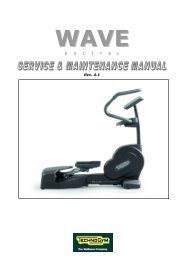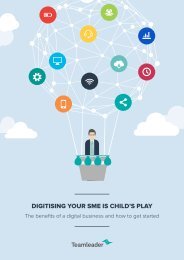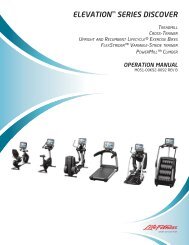Teamleader Ebook Build Better Relationships
You also want an ePaper? Increase the reach of your titles
YUMPU automatically turns print PDFs into web optimized ePapers that Google loves.
BUILDING BETTER RELATIONSHIPS:<br />
CUSTOMER CENTRICITY<br />
IN THE DIGITAL AGE<br />
1
1TABLE OF CONTENTS<br />
2<br />
3<br />
4<br />
5<br />
6<br />
CUSTOMER EXPECTATIONS ARE RISING:<br />
BECOME A CUSTOMER-CENTRIC BUSINESS<br />
WHAT’S A CUSTOMER-CENTRIC<br />
ORGANISATION ALL ABOUT?<br />
WHY DIGITAL MATTERS IN BECOMING<br />
A CUSTOMER-CENTRIC BUSINESS<br />
THE IMPORTANCE OF UNDERSTANDING<br />
THE DIGITAL CONSUMER<br />
HALITO!’S JOURNEY TO A<br />
CUSTOMER-CENTRIC BUSINESS<br />
3<br />
4<br />
7<br />
10<br />
17<br />
WORD OF THANKS<br />
Thank you for downloading this ebook. Don’t forget to share it.<br />
LEARN MORE<br />
FOLLOW US
2<br />
CUSTOMER EXPECTATIONS<br />
ARE RISING: BECOME A<br />
CUSTOMER-CENTRIC BUSINESS<br />
Contrary to popular belief, customer centricity isn’t just another buzzword. The customer has always<br />
been king, but is gaining more and more power every day. With digitisation on the rise, customers<br />
demand excellent services - any place, any time.<br />
How can you meet your customers’ expectations and become a more customer-centric organisation?<br />
In this ebook, you’ll learn all about what it takes. Read on, and discover:<br />
• WHAT A CUSTOMER-CENTRIC ORGANISATION IS ALL ABOUT<br />
We’ll let you in on the secrets of truly customer-centric companies. In fact,<br />
to become one, you don’t need to be a large enterprise. We explain how an<br />
improved customer experience can benefit your business as much as any<br />
other.<br />
• WHY SHOULD SMES BECOME MORE CUSTOMER-CENTRIC?<br />
Customers are more digital every day, so you need to meet your customers<br />
online too and improve your digital customer experience. Learn how you<br />
can offer them a single, seamless experience and how small changes can<br />
make a world of difference to become more customer-centric.<br />
• HOW A DIGITAL STRATEGY CAN BUILD A BETTER CUSTOMER<br />
EXPERIENCE<br />
Gerrie Smits, an authority on understanding the digital consumer and<br />
developing a digital strategy, explains how small businesses should react to<br />
digital trends. “Lots of companies still start from the ‘what’ - their product. If<br />
you can get them to think about the ‘why’, and really understand what their<br />
product or service means to customers, you get vastly different strategies,<br />
with vastly different results. Start from your customers’ needs, and go from<br />
there.”<br />
• HALITO!’S JOURNEY TO BECOME A CUSTOMER-CENTRIC BUSINESS<br />
A strategy for customer-centricity is important, but it doesn’t mean anything<br />
if you don’t put your words into action. Halito! is a company offering an<br />
online event platform for guest registration and communication. In just one<br />
year, the company managed to shift their approach from product-oriented<br />
to customer-centric. Their focus? ‘The happy flow’: “things can’t be overly<br />
complicated, simplicity and speed are essential.”
3<br />
WHAT’S A CUSTOMER-CENTRIC<br />
ORGANISATION ALL ABOUT?<br />
Acquiring and retaining customers has become increasingly harder. Customer loyalty is massively at<br />
stake. According to McKinsey, only 13% of all customers don’t shop around at all, while 87% actively<br />
search for competitor information, and 58% actually purchase from a competitor instead.<br />
Luckily, SMEs can turn the tide. Instead of primarily focusing on gaining new business, build long-term<br />
relationships with existing customers and gain their loyalty. To do so, becoming a customer-centric<br />
organisation is the way to move forward.<br />
EVERY SINGLE EXPERIENCE WITH A BUSINESS<br />
CAN MAKE OR BREAK A RELATIONSHIP<br />
In this day and age, customers really are king - if only for the never-before-seen<br />
pool of information they have access to, such as websites and social media<br />
reviews. This makes customers feel empowered and fully in control of any<br />
relationship with a business. A competitor is just a mouse click away. In fact,<br />
89% of customers would stop doing business with a company after a bad<br />
experience.<br />
Customers demand an excellent product or service, not just from large<br />
enterprises, but from small- and medium-sized companies too. If customers<br />
encounter a negative experience with a business, such as poor, unfriendly<br />
service, they’ll easily flock elsewhere. Plus, they won’t be afraid to share it<br />
through social media or chat about it with family and friends.<br />
To help you win, becoming a customer-centric business is the future.<br />
A truly customer-centric company puts customers at the<br />
forefront of everything they do.<br />
⊲ In a customer-centric business, customers are your number one priority.<br />
Without them, your business doesn’t mean much.<br />
⊲ Customer-centric companies provide what their customers value the most,<br />
without necessarily doing everything they want. Instead, they focus on what<br />
matters.<br />
4
WHA<br />
3 ELEMENTS THAT MAKE FOR A CUSTOMER-<br />
CENTRIC ORGANISATION<br />
1<br />
ENGAGE CUSTOMERS ON A REGULAR BASIS.<br />
Frequently keep in touch so they know you care. By setting up regular checkins<br />
with your customers (e.g. once every 3 months), they know they’re being<br />
heard. For example, send loyal customers a message with a special discount or<br />
offer to show appreciation. In addition, create useful content that addresses the<br />
needs of your customers and include it in your periodic newsletters or publish it<br />
on your blog.<br />
2<br />
KNOWING WHO YOUR CUSTOMERS ARE AND HOW YOU CAN BE OF<br />
VALUE TO THEM.<br />
It’s important to understand who your customers really are, what their interests<br />
are, and why they’ve decided to do business with you. A customer-centric<br />
business knows their customers in and out so you can better cater to their<br />
needs. The easiest way to understand who your customers are, and what they<br />
want is by simply asking them. Discover more on how to gather customer<br />
feedback and measure customer satisfaction.<br />
3<br />
MANAGING CUSTOMER EXPECTATIONS.<br />
As mentioned earlier, a customer-centric SME doesn’t do everything a customer<br />
wants. It’s tempting to try, but you can’t do right for everyone, all the time. That’s<br />
why you need to closely manage what customers expect from your business<br />
early on. For example, clearly document your product or service: what’s the<br />
best way to reach out to your business? What does your service consist of?<br />
What’s the pricing like? Be consistent, honest and transparent in everything you<br />
communicate. And carefully listen to your feedback channels to see if what you<br />
do is still up to par with the expected customer experience.<br />
5
WHAT’S HOLDING SMALL BUSINESSES BACK<br />
FROM INVESTING IN CUSTOMER CENTRICITY?<br />
“I JUST NEED TO SELL, I DON’T NEED TO TRANSFORM MY BUSINESS.”<br />
Acquiring new clientele is a key thing to survive, but “We need new customers!”<br />
can’t be the only thing that’s top of mind. If you just focus on volume, and not on<br />
the quality of your relationships, your customers likely won’t stay, and that will<br />
ultimately cost you money. In reality, customer-centric companies are 60% more<br />
profitable.<br />
“I ALREADY KNOW WHO MY CUSTOMERS ARE AND WHAT THEY WANT.”<br />
Think you’re already doing a great job? Don’t just assume so, because how<br />
customers feel has a massive impact on whether they will buy from you or not.<br />
According to McKinsey, 70% of buying experiences are based on how the<br />
customer feels they are being treated. The only way to truly get your customers<br />
is to talk to them, face-to-face if possible. You might be surprised by how open<br />
they will be for a discussion.<br />
“I NEED FAST ANSWERS, BUT I WILL PROBABLY ONLY SEE RESULTS IN<br />
MONTHS.” SMEs don’t have time to waste, and employees often juggle many<br />
responsibilities at once. That might shift attention a bit too much towards the<br />
short term. However, the journey to a customer-centric business starts with<br />
implementing bite-size and very attainable improvements. How do you find out<br />
where to start? Again, speak to your customers face-to-face, you’ll probably be<br />
able to write down 3 action points to start working on right away.<br />
CUSTOMER CENTRICITY IS NO LONGER A NICE-TO-HAVE<br />
Being a customer-centric business is necessary to<br />
keep a competitive edge in often dynamic, fastmoving<br />
markets. If everything starts and ends with<br />
the customer, overwhelmingly positive experiences<br />
can lead to long-lasting relationships which is<br />
essential for healthy small- and medium-sized<br />
businesses. So start to delight, grow and keep<br />
your customer base today.<br />
6
4<br />
WHY DIGITAL MATTERS<br />
IN BECOMING A<br />
CUSTOMER-CENTRIC BUSINESS<br />
Today, it’s not about what’s your most important priority - but who: your customers. But why is being a<br />
customer-centric business so utterly important? And what does digital have to do with it?<br />
Being customer-centric means:<br />
• More profitability<br />
• Increased customer satisfaction<br />
• A competitive advantage over competitors<br />
• Increased customer loyalty<br />
Unsurprisingly, this surge of customer centricity correlates with the hyperconnected<br />
digital age we live in. As a result, even small companies have<br />
to examine their digital efforts, combine them with a customer-centric<br />
company culture and manage the customer experience top to bottom if<br />
they want to stay in the game.<br />
IMPROVING THE DIGITAL CUSTOMER<br />
EXPERIENCE<br />
Nowadays, customers want to find what they need quickly and easily.<br />
According to Harvard Business Review, the most important factor to gain<br />
customer loyalty is to reduce customer effort, so make it as simple as possible<br />
for customers to reach out to you.<br />
A website is now a standard go-to source for customers. 83% of customers<br />
browse your website, and 70% even expect it to contain self-service<br />
information. But they’ll want to engage with your company on multiple others<br />
channels too, and expect a single, seamless experience across different<br />
platforms.<br />
Example: a customer might ask you a question through Facebook<br />
Messenger. If the same customer calls you on the phone, he will expect<br />
you to know all about the Messenger conversation.<br />
7
In the age of digitisation, small businesses have to adapt. Stakes<br />
are high, as 86% of customers will pay more for a better customer<br />
experience. Improving the digital customer experience is therefore<br />
necessary to meet and exceed expectations. But what does that<br />
actually mean?<br />
A digital customer experience is the sum of all digital interactions<br />
between a customer and a company and influences how customers<br />
perceive your business.<br />
HOW CAN SMES ENSURE A BETTER DIGITAL<br />
CUSTOMER EXPERIENCE?<br />
1<br />
CREATE A CUSTOMER-CENTRIC MINDSET.<br />
When thinking about digital customer experience, culture outweighs<br />
technology. Companies with the right technology still need to embrace a<br />
customer-centric mindset. Of course, technology is an important basis for<br />
building a better customer experience and helps you drive revenue and<br />
growth. But shift your employees’ mindset so they start developing this<br />
mentality too.<br />
2<br />
CREATE A SUPERIOR EXPERIENCE EVERYWHERE.<br />
Focus on improving the digital experience throughout all the steps a customer<br />
goes through when considering, purchasing, using, and maintaining loyalty<br />
to your product or service - also called the customer lifecycle. Investing the<br />
majority of your resources in sales and marketing, while neglecting customer<br />
service, retention, and engagement, is a losing bet. You should create superior<br />
experiences during every encounter a customer has with your company, if you<br />
want to make them truly happy.<br />
As a small company, you might already have the edge over large corporations:<br />
small businesses are known for providing a more personal customer<br />
experience. Live up to those expectations and convince your clients every day<br />
why they should stay with you.<br />
8
5 DIGITAL ESSENTIALS OF A CUSTOMER-<br />
CENTRIC BUSINESS<br />
To deliver this superior customer experience, focus on the following five things<br />
which characterise every customer-centric business.<br />
• FAST HELP<br />
Consumers are very impatient online. Make sure your website loads quickly,<br />
is easy to navigate and offers all the right information, so your consumers<br />
don’t give up and leave. The same applies to answering questions or<br />
complaints: try to respond as fast as possible. Having a system in place that<br />
helps you follow up on communication with customers, could really help<br />
improve your response time.<br />
• BRAND CONSISTENCY<br />
A customer’s impression of a brand is like a mosaic, made up of different,<br />
individual touch points. The overall perception has a big influence on<br />
customer loyalty, convincing customers to stay if you provide a consistent<br />
digital experience.<br />
• RELIABILITY<br />
Customers don’t want to repeat themselves over and over again when<br />
they’re interacting with you through different channels. In fact, Accenture<br />
claims that 89% of customers get frustrated if they have to reiterate over and<br />
over again. Use software to support you, tracking all interactions and tying<br />
them together across all channels.<br />
• MEASURING TO IMPROVE<br />
Measure how your customers feel about your business to find opportunities<br />
for improvement. Don’t assume your customers will proactively inform you if<br />
they had a rather negative experience. Customers rarely find the time for it,<br />
and by the time they express their dissatisfaction, it’s already too late.<br />
Measuring customer satisfaction is easy: learn which strategies you can use<br />
• RECOGNISING VALUABLE CUSTOMERS<br />
Truly customer-centric organisations identify their most valuable customers<br />
and ensure they are (and stay) satisfied, by personalising their messaging,<br />
following up on them flawlessly and offering proactive support.<br />
9
5<br />
THE IMPORTANCE<br />
OF UNDERSTANDING<br />
THE DIGITAL CONSUMER<br />
As said earlier, the way in which customers interact with businesses continues to evolve. Digital<br />
strategy consultant Gerrie Smits believes businesses should focus on truly understanding their<br />
customer - above all else.<br />
Keynote speaker and digital strategist, Gerrie Smits, has over 20 years of experience in industries<br />
disrupted by the internet, and is a hands-on expert in dealing with the impact of technology on all<br />
sorts of businesses, products and most importantly: people.<br />
GERRIE SMITS’ 6 TAKEAWAYS TO DEVELOP A<br />
DIGITAL CUSTOMER-CENTRIC STRATEGY<br />
1<br />
THINK ABOUT ‘WHY’ YOUR COMPANY EXISTS<br />
Smits explains that any business that fails to embrace customer centricity today,<br />
will fail altogether. “Lots of companies still start from the ‘what’ - their product.<br />
But you need to think about the ‘why’, and really understand what your product<br />
or service means to customers, and you’ll get a greatly different strategy with<br />
different results. Start from your customers’ needs, and go from there.”<br />
“To be able to truly embrace customer centricity, start from<br />
your customers’ needs, and go from there.”<br />
“A good quote in that respect: Every team needs to have a customer. If you<br />
don’t have a customer in mind, you can’t know what you’re working for. A<br />
customer could be multiple people - even within your organisation - but it’s<br />
such a simple, fundamental insight. If you, your team and other departments<br />
don’t know what you’re working for, why bother?”<br />
As a framework, many of Smits’ customers start to embrace ‘Design Thinking’,<br />
which helps to understand and pursue innovation - in ways that contribute to<br />
organic growth, and add real value to your customers. “The fact that it’s on the<br />
radar of many major corporates clearly means a shift is taking place.”<br />
10
2<br />
HIRE PEOPLE WITH EMPATHY<br />
As Smits puts it, “today’s shift towards a digital business also affects other<br />
aspects of your company. Take HR strategy, for instance. In an increasingly<br />
digital world, SMEs need to understand what their customers desire. And to<br />
help your team figure out what that is, you’ll also need new hiring criteria.”<br />
“Empathy allows us to experience and understand what<br />
customers want.”<br />
People who master listening and responding with empathy perform better in<br />
coaching, engaging others, planning and organising, and decision-making. Yet<br />
empathy is on the decline for most businesses: with advancing technology, it<br />
has become standard practice to send automated emails or texts instead.<br />
“Empathy really is the most important skill to be successful. It allows us to<br />
experience and understand what customers want, the struggles they deal with<br />
and the added value they are looking for.” By placing the customer at the heart<br />
of what we do - e.g. by creating Buyer Personas, adding customer touch points<br />
- we are better positioned to respond to their needs, including those that are<br />
unknown or unarticulated.<br />
3<br />
KEEP UP WITH (TECHNOLOGY) TRENDS<br />
“Businesses should understand where things are going. What is happening<br />
today, and how will this affect my customers? If it turns out that at a certain<br />
point, your customer expects things to be automated and machine learning is<br />
the best technology for them - how will you react as an SME?”<br />
“Businesses should catch the COD: the Characteristic of<br />
Digital.”<br />
Businesses should be aware of trends, “Or as I like to call it, ‘catch the COD’<br />
(Characteristic of Digital). You need to understand why things are becoming<br />
more important, the underlying motive of customers. Take chatbots - they’re<br />
efficient, and help people who don’t like making phone calls. They allow<br />
customers to contact you through different channels. It will be the clue<br />
to success for businesses, however small or large, to understand which<br />
technology will be fit for whom, and which need it will solve.”<br />
11
4<br />
BUILD AND MAINTAIN CUSTOMER LOYALTY BY COMBINING DIGITAL<br />
WITH HUMAN<br />
If you look at the underlying motives of customers today, one thing stands out:<br />
people want a relevant, personal experience. “That’s also the reason face-toface<br />
contact still works like a charm. But spending 30 minutes talking to each<br />
customer also has a downside: scalability.”<br />
“Digital solutions nowadays can mimic a personal approach in<br />
a scalable way.”<br />
But the digital and the personal approach are not polar opposites. Data can be<br />
used to segment your customer base, personalise the customer experience...<br />
For example, by identifying your loyal customers, you can send them a<br />
personal thank-you card. “Nowadays digital solutions mimic the same personal<br />
approach, while being scalable at the same time.”<br />
“Sometimes you can convince someone of your story by sending an automated<br />
series of emails. Sometimes you’ll need to talk to a potential customer<br />
personally for 30 minutes. I believe businesses who are able to combine those<br />
two seamlessly - the digital and human aspect - will have more chances of<br />
success.”<br />
5<br />
DON’T BE AFRAID TO CHALLENGE THE STATUS QUO<br />
Businesses should dare to question themselves. “Don’t be afraid to challenge<br />
the status quo. What works today, might not work tomorrow. How will you - and<br />
your business - adapt to this ever-changing reality?” Social media presence<br />
is one of those things. The way businesses use social media today might<br />
drastically change over the years to come. And what works for the majority,<br />
might simply not work for you - or vice versa.<br />
“You need to figure out where you’re going, but dare to be<br />
agile.”<br />
That’s the mindset any type of SME should have today. Don’t think you’re right,<br />
by default. “You need to figure out where you’re going of course, and stick to<br />
the plan, but dare to be agile. Know who your customer is, and don’t be afraid<br />
to follow a trend or evolution as you go along.”<br />
The biggest challenge for SMEs is understanding digital consumers: “don’t think<br />
technology will be the answer to everything without any effort from your side.<br />
Why worry about your social presence if you don’t understand why people are<br />
on social media in the first place? Who are your customers, why are they buying<br />
my product, and how is that process changing? What impact will technology<br />
have on my relation with existing customers? Or new customers in the next 3 to<br />
5 years?”<br />
12
6<br />
“PRODUCT FIRST, EVERYTHING ELSE COMES LATER” ISN’T A VALID<br />
APPROACH<br />
“It has never been easier to launch a new product or business, and with the<br />
fierce competition in every industry, you’ll instantly lose an edge if you don’t<br />
put your customer first. In the age of digital consumers, competitors that don’t<br />
necessarily offer a superior product, but that do focus on customer centricity,<br />
will quickly take your place.”<br />
“If you don’t start from customer data or market research, your<br />
offer might be a prototype instead of something marketable.”<br />
“If your product or service is completely aligned with the market requirements,<br />
great. But SMEs and start-ups: if you don’t start from customer data or market<br />
research, chances are your offer will be more of a prototype instead of<br />
something marketable.”<br />
“Starting from your product and assuming it’s the right answer is simply<br />
dangerous. If you don’t know your customer wants user-friendliness, you won’t<br />
do anything about it either. You’ll always start from your own version of the truth<br />
- which will inevitably render you less competitive in the long run.”<br />
13
EMBRACING THE<br />
DIGITAL CONSUMER<br />
THE<br />
FACTS<br />
90%<br />
71%<br />
45%<br />
92%<br />
72%<br />
of retail shoppers use<br />
a digital device while<br />
shopping in-store.<br />
of consumers use a<br />
digital device before<br />
going shopping.<br />
of companies have limited to no<br />
understanding of how customers<br />
interact with them digitally.<br />
of people trust<br />
recommendations from<br />
individuals they know.<br />
of consumers trust online<br />
reviews as much as<br />
personal recommendations.<br />
(Source: Marketingprofs.com)<br />
(Source: McKinsey)<br />
(Source: Moderncomment.com)<br />
<strong>Better</strong> Customer Experience leads to customer satisfaction,<br />
reduced churn, increased revenue and employee satisfaction.
THE<br />
TRENDS<br />
BEFORE<br />
NOW<br />
Start from the ‘what’<br />
Product<br />
Start from the ‘why’<br />
Customer<br />
Hard skills # 1 hiring criteria (e.g.<br />
language proficiency, writing skills, programming<br />
skills, certificates)<br />
Soft skills increasingly important<br />
(focus on empathy)<br />
Universal, one-size-fits-all<br />
approach<br />
Personal, tailored experience<br />
for each customer
THE<br />
FLIP<br />
From<br />
a traditional, self-centric approach to<br />
customers at the heart of everything you do:<br />
(Source: www.gerriesmits.com)<br />
Customer<br />
experience<br />
Tech /<br />
IT<br />
HR /<br />
Talent<br />
Process<br />
Product<br />
Marketing / Comms
6<br />
HALITO!’S JOURNEY TO A<br />
CUSTOMER-CENTRIC BUSINESS<br />
How can SMEs adopt a customer-centric approach? Halito!, a company active in the event industry,<br />
is the perfect example of a customer-centric business that goes to great lengths to build better<br />
relationships with their customers on a day-to-day basis. Discover their full story.<br />
Halito!’s an online platform for the event industry designed for guest registration<br />
and communication and is mainly active in Europe, more specifically in the<br />
Netherlands, Belgium and Ukraine.<br />
In 2016, Halito started their own Customer Success department. The main focus<br />
in their customer-centric strategy is ‘The happy flow’, a powerful framework<br />
they’ve designed which boils down to the following:<br />
“How we organise our business can’t be too complicated.<br />
Simplicity and speed are essential in everything we do, and<br />
we never forget to smile while we’re at it.”<br />
Although success didn’t come overnight, their focus on proactive support and<br />
customer involvement paid off relatively quickly:<br />
“In just a year’s time, Customer Success really has become<br />
one of the most important departments.”<br />
1<br />
So how did Halito! adopt this new approach? By implementing the following 5<br />
changes:<br />
MEASURE CUSTOMER SATISFACTION<br />
“First, we send out really simple customer surveys at a regular interval, mainly<br />
focusing on 5 key performance indicators (KPIs):<br />
• Focus<br />
• Speed<br />
• Accuracy<br />
• Clarity<br />
• Friendliness<br />
“We then ask customers to fill out this survey as honestly as possible, along<br />
with one open-ended question (Do you have any tips to help us improve?).<br />
This, combined with our Net Promoter Score, gives us key insights into how we<br />
are perceived, things we do well and factors we can improve upon.”<br />
17
2<br />
FREQUENT, PERSONAL, FACE-TO-FACE COMMUNICATION<br />
“Our Marketing team sends monthly customer newsletters through MailChimp.<br />
For example, we can segment our database based on location to send<br />
targeted emails for an event in a specific area. We also attend several fairs<br />
throughout the year, where we actively meet up with customers and send out<br />
personal invitations in advance.”<br />
“Customers appreciate seeing us, and we get to hear fresh ideas or desires, or<br />
even questions they’re stuck with. A lot of customers really value this personal<br />
relationship, and so do we. It allows us to increase customer involvement,<br />
exchange ideas and get inspired. And it’s also a key step towards building a<br />
community of stakeholders around our business.”<br />
3<br />
TAILORED TRAINING<br />
This year, Halito! started providing personal training sessions at their offices,<br />
as well as online. “Online training helps us save time. With today’s technology,<br />
you can share your screen to demonstrate what the user will need to do. The<br />
training we provide at our offices is more personal and tailored to the needs of<br />
that particular customer.”<br />
“We really take our time to listen - we’re not there to tell them what to do,<br />
we’re there to hear what they need. These in-house training sessions also<br />
allow us to share our personal findings and best practices, and introduce<br />
customers to our software at their own pace.”<br />
18
4<br />
5<br />
KEEP AN EYE ON IMPORTANT BUSINESS METRICS<br />
“As an IT business, we’re really into numbers and also actively use software to<br />
help support our customer-centric efforts. That’s why we’ll start using<br />
Cumul.io, a rich, straightforward data analysis platform that allows you to quickly<br />
get actionable insights, to gain a better understanding of our statistics and<br />
KPIs.”<br />
“In addition, <strong>Teamleader</strong>’s ticketing module allows us to see our first and<br />
average response time, when we receive most tickets, the full resolution time<br />
for each issue, and individual performances within our team. We also created<br />
custom fields in <strong>Teamleader</strong>’s CRM module to grant the marketing team some<br />
key insights. This way, we can filter on specific segments and send targeted<br />
email campaigns - to get the right message to the right audience.”<br />
COMBINE CRM, TICKETING AND PROJECT MANAGEMENT<br />
“<strong>Teamleader</strong> lets us improve customer relations, centralise all information and<br />
manage our entire business in one versatile CRM tool. It gives us easy but<br />
profound customisation options: suppose you’d like to send a personal email<br />
with a special offer or call customers on their birthday. Small efforts like that go<br />
a long way.”<br />
“To help solve questions of our customers, we use <strong>Teamleader</strong>’s ticketing<br />
module. We first had our own ticketing tool, but it’s just way easier to combine<br />
multiple functionalities in one software. Practical questions are picked up by<br />
one colleague; if we receive technical questions, we simply assign tickets to<br />
the right developer. It helps us focus and maintain a clear overview.”<br />
“Aside from those practical questions, we also manage projects for our<br />
customers from start to finish when, for example, an event is complex. We can<br />
even grant our customer insight into the status of their project online. Again,<br />
this helps us improve customer relationships and involvement altogether.”<br />
19
WHY NOT GIVE TEAMLEADER A TRY?<br />
Want to become a customer-centric business, and go the extra mile for your customers? With its CRM,<br />
ticketing, project planning, and invoicing module, <strong>Teamleader</strong> is the ideal solution for SMEs that want<br />
to improve their customer experience and build better relationships.<br />
KEY FEATURES<br />
Stay on top of every<br />
relationship and keep<br />
close track of every<br />
touchpoint in the CRM<br />
module<br />
Personalise your<br />
communication with<br />
custom segments, tags,<br />
and custom fields<br />
Provide a great<br />
customer experience:<br />
allow customers to<br />
approve quotes online<br />
Meet your customers’<br />
demands: answer<br />
questions right away<br />
with the ticketing<br />
module<br />
Go ahead: give it a try for free!<br />
Or dive deeper into the<br />
different modules, and take a<br />
tour of the product:<br />
START YOUR 14-DAY FREE TRIAL<br />
TAKE THE TOUR<br />
20

















